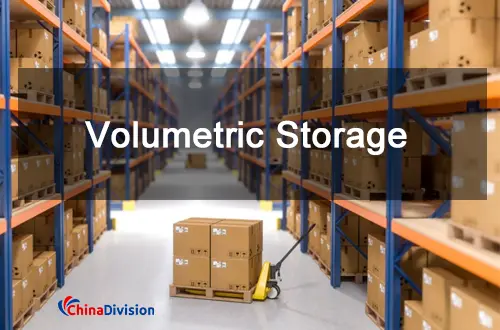Maximize warehouse efficiency with volumetric storage
Many businesses are facing problems with inaccurate storage charges, excess inventory, and poor space utilization, leading to increased costs and operational challenges. How can you achieve efficient storage and management of goods within limited warehouse space? As an important concept in the field of logistics, volumetric storage is gradually becoming the key to solving this problem.
Table of Contents
- What is volumetric storage?
- Methods for calculating storage capacity in warehouses
- How to calculate the storage capacity of a container?
- What are the advantages of volumetric storage in logistics?
- Methods and steps to effectively implement volumetric storage
- How can Chinadivision fulfillment agent service providers help?
This article will take a deep look at volumetric storage in logistics, especially the method of calculating storage capacity for warehouses, the importance of container content volume, and how Chinadivision, as an international fulfillment service provider, can provide practical solutions for B2B companies and e-commerce sellers.
What is volumetric storage?
Volume storage measures the space your goods take up in cubic feet and charges accordingly. Unlike traditional pallet storage, which can lead to inaccurate charges and excessive costs, volumetric storage ensures that you only pay for the space you use. The core of volumetric storage is to maximize the use of every inch of warehouse space to ensure the safe storage and efficient circulation of goods.

For example, some goods may be light in weight but take up a lot of space (e.g., large but light items such as pillows, inflatable plastic products, etc.). On the other hand, some products may be heavy but small in size, and volumetric storage allows companies to effectively optimize space for both types of goods.
Methods for calculating storage capacity in warehouses
Calculation based on item volume
Applicable to goods with fixed volume and shape. By measuring the length, width, and height of the goods, its volume is calculated and the storage space of the warehouse is planned accordingly.
Calculation based on item weight and density
For goods with heavy weight or uneven density, the storage space can be calculated by combining their weight and density to ensure the reasonable allocation of the warehouse's load-bearing capacity.
Comprehensive calculation method
Combining the volume, weight, quantity of the goods and the actual layout of the warehouse, a more complex algorithm is used to calculate the storage capacity to maximize space utilization.
How to calculate the storage capacity of a container?
Determining the storage capacity of a container is simple. You just need to measure its length, width, and height in feet and multiply these dimensions. Available volume = maximum stack height × effective floor area × stacking factor. For example, the dimensions of a standard 20-foot container are approximately 19.5 feet long, 7.5 feet wide, and 7.5 feet high, so its storage capacity is approximately 1,059 cubic feet.
- 20-foot standard container: volume is approximately 33 cubic meters.
- 40-foot standard container: volume is approximately 67 cubic meters.
- 40-foot high-cube container: volume is approximately 76 cubic meters.
But it should be noted that not all space can be used, depending on the type of goods stored and how they are arranged. If the goods you are transporting are irregular in shape or bulky, the capacity of the entire container may not be effectively utilized. This is where optimizing storage becomes crucial.
The storage volume of a shipping container determines the maximum amount of goods that can be loaded, which directly affects logistics costs and transportation efficiency. When choosing a container, B2B companies and e-commerce sellers must fully understand and reasonably utilize its storage volume to avoid wasting space and increasing transportation costs.
What are the advantages of volumetric storage in logistics?
Accurate cost calculation
Compared with the traditional pallet-based model, volumetric storage can measure storage needs more accurately. This ensures that you only pay for the space you use, reducing unnecessary costs.
Optimize space utilization
By focusing on actual capacity, volumetric storage can effectively utilize warehouse space. This helps prevent overloading and damaged goods, which can occur when pallets are overloaded.
Improve inventory management
Volumetric storage is in line with agile inventory management practices. It rewards companies for maintaining optimal inventory levels, reducing excess inventory and related costs.
Simplify storage management
Unlike pallet storage, which requires precise palletizing, volumetric storage simplifies the process. You only pay for the volume of goods regardless of how the goods are arranged in the warehouse.
In the field of logistics, volumetric storage can not only increase the storage density of warehouses and reduce unit storage costs, but also optimize the circulation path of goods and improve logistics efficiency. For B2B companies and e-commerce sellers, this means faster order response, lower operating costs, and stronger market competitiveness.
Disadvantages of volumetric storage in logistics
Initial planning is complex: detailed cargo volume and warehouse space data are required, and initial planning is relatively complex.
Lack of flexibility: Fixed storage arrangements may not be flexible enough to respond to unexpected demands and changes.
Safety considerations: Regulations and best practices must be strictly followed to prevent accidents and ensure the safety of warehouse staff.
Methods and steps to effectively implement volumetric storage
Assess your current storage needs
Assess the volume of goods you store and identify areas that need optimization. Use warehouse management software to track inventory levels and accurately calculate storage volumes.
Choose the right partner
Partner with a logistics provider that offers advanced volumetric storage solutions. For example, Chinadivision, as an international fulfillment service provider, can help you optimize your storage operations and reduce costs.
Optimize inventory levels
Develop a strong inventory management strategy to maintain optimal inventory levels. This not only reduces storage costs but also improves cash flow.
How can Chinadivision fulfillment agent service providers help?
Volumetric storage provides a precise and effective warehouse storage management method that reduces costs and improves operational efficiency.
Intelligent warehouse planning
Use advanced warehouse management systems (WMS) to achieve intelligent classification, location and tracking of goods to maximize the use of warehouse space.
Customized Storage Solutions
Based on the characteristics and needs of customers' goods, we provide customized storage solutions, including shelf layout, cargo stacking methods, and inventory turnover optimization.
Container Loading Optimization
Through professional loading software and an experienced operation team, we ensure the reasonable placement of goods in the container, maximize the use of storage volume, and reduce transportation costs.
Logistics and Supply Chain Integration
Provide one-stop logistics services from warehousing, sorting, packaging to transportation, realize the transparency and efficiency of the supply chain, and help customers improve their market competitiveness.
Volume storage is not just a way to calculate warehouse or container space, it is also a strategic advantage to optimize logistics and reduce costs. By better understanding the volume of goods, you can manage inventory more effectively, optimize warehouse space, and reduce transportation costs.
By working with Chinadivision, you can optimize your storage operations with advanced logistics solutions. If you are ready to transform your logistics processes and improve efficiency, contact Chinadivision today. Let us help you deal with the complexity of volumetric storage and achieve your business goals.





